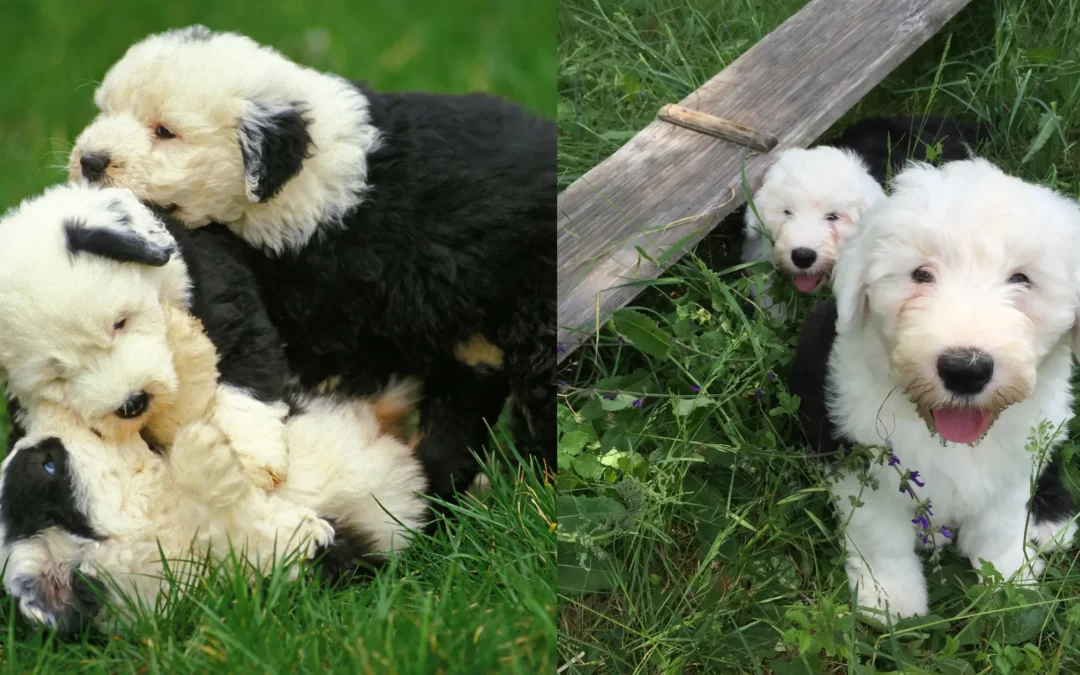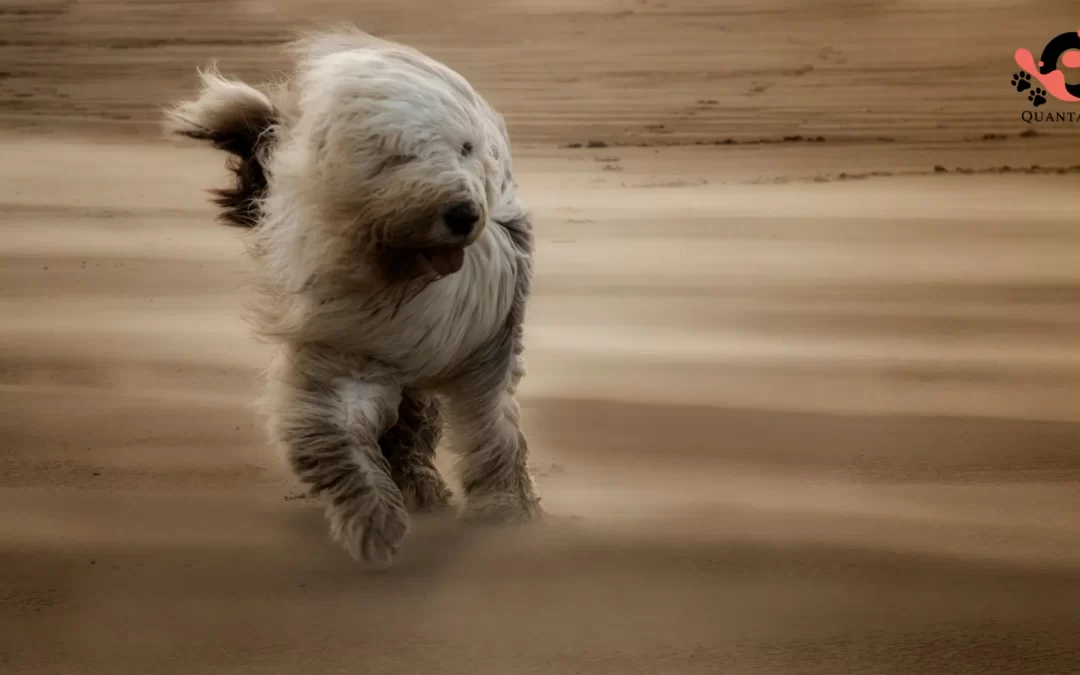Whenever walking our Old English Sheepdog Noah, we are approached by many dog lovers in order to pet, play or simply take a picture with her. Kids are the best! They rarely think about the dog breed, but rather see a goofy ball of fluff and just want a hug. However, more and more adults ask us if Old English Sheepdogs are hypoallergenic, how to deal with their hair, are they good with kids, and if there is a way to maintain their coat hypoallergenic. In this article we provide some insights on allergies, we also summarize information to assist when making decision if your new fluffy family member will be an OES, and how to maintain your household if you already live with an Old English Sheepdog.
There is no such thing as a truly hypoallergenic dog. American Kennel Club (AKC) does not consider Old English Sheepdogs hypoallergenic; however, there are straightforward actions you can take to maintain their coat hypoallergenic and your household organized and purified so that you don’t need to part ways with your fluffy family member. Some owners reported that even though they suffer from dog allergies, they did not have any allergic reactions to Old English Sheepdogs. Why is that?
What causes Old English Sheepdog allergies?
When getting a pet is an anticipated event of the household, it would be devastating to discover that one of the family members is allergic to the new fluffy friend. According to the statistics of the Asthma and Allergy Foundation of America, 3 out of 10 Americans with allergies would have allergic reactions to their pets. It is more common to have cat allergies than dog allergies. In their prominent review article, immunology experts dr. Chan and dr. Leung discovered that 10 – 20 per cent of worldwide population is affected by some sort of dog or cat related allergies.

It is important to state that dog allergies are caused by the protein found in dander, saliva and urine and not in the hair or fur. We should also note that all dogs have these proteins and none of them are allergy-free. Therefore, it would be false to conclude that dog that sheds less would be completely safe for allergic people, as the dander would still prevail. However, less shedding dogs would be more allergy-friendly, especially if groomed frequently.
Human body reacts to the pet-related allergen by considering the dander or saliva protein as an “enemy” and then produces antibodies to fight that mistakenly recognized enemy. Depending on the exposure, allergic reactions could be mild, moderate or severe. The symptoms could include coughing, breathing difficulties, sneezing, watery and itchy eyes, wheeze, skin rashes or hives, anaphylaxis, or eczema flare. If you suspect allergies, it is important to consult your medical doctor in order to get appropriate care and treatment.
Should I get an allergy test before adopting an Old English Sheepdog?
According to The British Allergy Foundation , people with allergic asthma or hayfever are commonly allergic to dogs and cats, so it is likely to expect some reactions when in contact with dog’s saliva or dander. For the people who never experienced any allergic symptoms, allergy tests would be unhelpful, because results would be inconsistent and there is a chance that subsequent exposure would still lead to allergic reaction even though person was never allergic in the past.
Considering that tests could be inconclusive, a safe approach would be to “rent-a-pet”. Sure, it sounds silly, but if you do have a family member or a friend that has a dog, you could take the dog for a sleepover in order to expose your living quarters with some dander. Dander will usually stay in your home for some time, so be tactical and keep the dog in few rooms of your home. Alternatively, you could spend some time in the friend’s house or volunteer in the local animal shelter to get some exposure. In case you get some symptoms, it is the best to visit medical professional and consult about your pet ownership.
Some people could be worried about bringing newborn babies to their home with a dog, or to introduce a dog to the household with small kids, but the study conducted in Great Britain with 620 infants actually showed that exposure to pets at an infant stage either decreased or had no effect on allergies once those infants reached the age of 12 years old.

What can be done to reduce exposure to allergens from an Old English Sheepdog?
Many members of the OES club stated that they have allergies to multiple allergens, but do not have any issues with their Old English Sheepdogs, while others did some small adjustments in their lifestyles and managed to live with their OESs without issues. If you have developed allergy symptoms and a health professional has determined that you suffer from a dog allergy, there are several steps you can take to reduce the exposure to the dog’s dander:
1. Avoid adoption or readopt your OES
In case your allergy reaction is too severe, a qualified health practitioner will probably advise that you avoid any contact with pets and urge you to reconsider an Old English Sheepdog adoption. As reported in The Sun, 34% of pet owners give away their pets after getting allergy symptoms, while further 28% consider parting ways. If you already adopted an OES, his advice could be to remove your dog from the household. Some would choose to adhere to these recommendations, but some would still prefer not to part with their fluffy family members. If you opt for the latter, there is a chance that you will need to invest your time in grooming and cleaning, or even to medicate in order to sustain symptom-free life.
2. Increase grooming frequency
Old English Sheepdogs do not have fur, but rather a hair. A lot of hair. So, it might take a lot of grooming efforts to ensure that dander would be removed from their hair. As you probably already know, recommended grooming frequency is three to four hours per week, but if you are affected by the OES dander allergies, you would probably have to groom even more frequently. No matter how well-groomed they are, Old English Sheepdogs love to cuddle and play. That will certainly lead to hair on your furniture, your clothes or food. Of course, you can also opt to maintain short cut for your OES, which will avoid long hair accumulation in your home.
Let’s be honest, grooming your fluffy pooch is not going to be an easy task. In order to live comfortably in harsh weather conditions, Old English Sheepdogs have two layers of hair. Top layer that is exposed to the weather conditions and an undercoat that serves as an additional layer of protection from the weather. While the outer layer is rough, undercoat is soft. Obviously, as the undercoat is in direct contact with the dander, your main task would be to take care of the undercoat. Unlike the top layer, dead hair of the undercoat will not fall off on its own, so it is necessary to remove the undercoat regularly. However, excessive removal of the undercoat could lead to skin issues, so it is necessary to find a good balance when grooming your OES baby. You can find more on grooming tips in this guide.

3. Make adjustments in your home
So, you have decided to keep your pooch and you are ready to do whatever it takes to milden allergic symptoms. It will definitely take some commitment from the household members.
If you have a house, consider installing special pet door so that your pooch can enter and exit your house frequently. We had eight OESs since mid 1980’s and all of them enjoyed their time outdoors. Even our two present girls love to stay outside, regardless of the weather conditions. Keeping them outside for several times per day will allow them to interact with the yard and remove their dead hair in a natural way, especially if you have any bushy plants.
Considering your allergic reactions, you could also consider keeping your OES outside of the bedroom in order to prevent buildup of the dander in the areas where you sleep. As allergen proteins build up in urine and saliva, you have to ensure there is no urination in the house (potty train your puppy early on) and avoid licking of your hands or face. You will have to wash your hands thoroughly if you have been playing with your pooch, before you touch your face again.
It will take some time, but if you are patient, you will be able to train your Old English Sheepdog to stay clear of zones in your house that you want to maintain allergen free. As it is harder to clean softer areas, make sure you work with your puppy to stay off sofas or beds. You can also increase bedding wash frequency, especially your dog’s beddings.
Cleaning is fun for some, but most of us do not like the process of cleaning, while we enjoy a clean house. If you are allergic to your OES pooch, you will have to increase frequency of cleaning certain parameters; especially cleaning dust regularly. It is highly likely that you will be allergic to dust mites and other airborne allergens, so regardless of owning an Old English Sheepdog, you will have to clean your dust more frequently. You will also have to clean your carpets with powerful vacuum cleaners that have HEPA (High Efficiency Particulate Air) filters. In order to avoid dust sticking to your floors, you will have to clean the floor with warm soapy water. Finally, investing in a good air filtration for your home HVAC or a simpler air purifier could be helpful to reduce impact from the airborne allergens.
4. Alternative breeds
In case you are discouraged to adopt an Old English Sheepdog, but would still like to own a pooch, then there are some recommended hypoallergenic dogs that would be a better fit for anyone with stronger allergy symptoms. As stated earlier, there is no such breed as truly hypoallergenic dog, but Poodle (standard, toy or miniature) is considered as one of the least allergenic dog breeds. Irish Water Spaniel and Portuguese Water Dog are highly recommended by the American Kennel Club as great alternatives for people with dog allergies. As you are considering OES as your next family member, you probably prefer larger dog breeds, so another good alternative would be Giant Schnauzer or Kerry Blue Terrier.
Final Thoughts
There are no truly non-allergenic dogs, so there are cases where Old English Sheepdogs caused allergic reactions. However, there are remedies and lifestyle changes that could still allow for a goofy ball of fluff adoption. It is good to keep in mind that, even though AKC does not consider an OES as a hypoallergenic dog, Old English Sheepdogs have a layer of undercoat that capture dander, so with proper grooming, exposure can be controlled. Other controlled measures include proper cleaning of your home and restricted areas for your OES. Alternatively, you can consider AKC’s recommended hypoallergenic dog breeds and find a substitute breed to adopt.














0 Comments